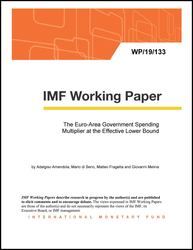
The Euro-Area Government Spending Multiplier at the Effective Lower Bound
We build a factor-augmented interacted panel vector-autoregressive model of the Euro Area (EA) and estimate it with Bayesian methods to compute government spending multipliers. The multipliers are contingent on the overall monetary policy stance, captured by a shadow monetary policy rate. In the short run (one year), whether the fiscal shock occurs when the economy is at the effective lower bound (ELB) or in normal times does not seem to matter for the size of the multiplier. However, as the time horizon increases, multipliers diverge across the two regimes. In the medium run (three years), the average multiplier is about 1 in normal times and between 1.6 and 2.8 at the ELB, depending on the specification. The difference between the two multipliers is distributed largely away from zero. More generally, the multiplier is inversely correlated with the level of the shadow monetary policy rate. In addition, we verify that EA data lend support to the view that the multiplier is larger in periods of economic slack, and we show that the shadow rate and the state of the business cycle are autonomously correlated with its size. The econometric approach deals with several technical problems highlighted in the empirical macroeconomic literature, including the issues of fiscal foresight and limited information.
Publication date: June 2019
ISBN: 9781498314947
$18.00
Add to Cart by clicking price of the language and format you'd like to purchase
Available Languages and Formats
| English |
Prices in red indicate formats that are not yet available but are forthcoming.
Topics covered in this book
This title contains information about the following subjects.
Click on a subject if you would like to see other titles with the same subjects.
Fiscal multiplier , Zero lower bound , Panel VAR , Factor models , Euro Area , , ELB , normal time , ZLB , endogenous variable , GFC
Also of interest
Summary
Copyright © 2010 - 2025
Powered by:
AIDC



